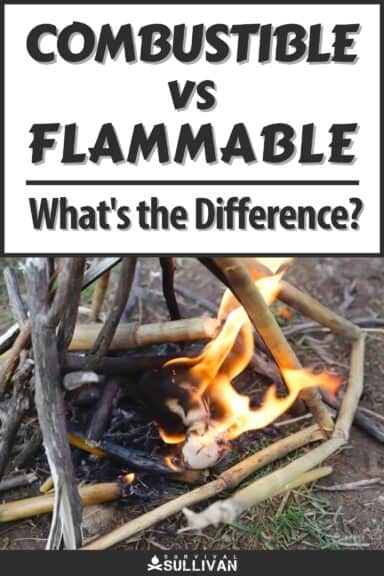Fire safety is a big deal. And it’s a big deal in more ways than you think. Everyone understands the importance of being prepared against a house fire, but even out in the world, there are all kinds of substances around us that compose a substantial fire hazard, some worse than others.

It’s common to see warning placards labeled flammable, combustible, and more. But are these terms synonyms? Just what is the difference between combustible and flammable?
Generally, any substance that is classified as flammable has a much lower ignition temperature, or flashpoint, compared to one that is classified as combustible.
Note that different agencies and organizations have drastically different metrics for these labels!
Most of the time, common folks like us use the terms “combustible” and “flammable” interchangeably.
But, when you get into transportation, industrial, and materials signage, the terms are anything but synonymous.
And this isn’t just a factoid for nerds, either, because understanding the difference between flammable and combustible materials is valuable intelligence that will influence how you store, interact and respond to these materials in an emergency.
There’s a lot more you’ll want to know, so keep reading…
Important: Different Agencies and Organizations Have Different Standards!
The most important thing you need to know concerning all of this is that different agencies and organizations have different standards for determining what flammability is and what combustibility is. Sometimes, the differences can be very significant!
By way of a “for instance”, OSHA, the Occupational Safety and Health Agency, classifies flammable liquids as having a flash point (the point at which they emit vapors which can ignite) of 199.4°F with further specific classifications beyond that.
Typically, OSHA classes combustible liquids as having flash points between 200°F and 400°F.
Contrast this with the National Fire Prevention Association or NFPA, which classifies flammable liquids as having a flashpoint of only 100°F or less, meanwhile they class combustible materials as igniting between 101°F and 200°F.
Quite a big difference, considering the latter means that it can readily ignite not too far above room temperature!
This is where not understanding different classification standards can get you into major trouble…
If you assume you’re dealing with a different and much higher temp for ignition when you’re actualy dealing with one that indicates a much lower flash point, the stage could be set for disaster depending on how you are transporting or storing flammable materials!
A comprehensive review of the different agencies that have a stake in these classifications is beyond the confines of this article, so make sure you look up the relevant ones for your industry, workplace or area, and when in doubt just get a hard figure concerning the temperature!
Flammable is Technically Only Applied to Liquids
Since we’re talking about the technical definitions of flammability, I should also point out that flammable is a term that, technically, only applies to liquids.
Most of us think of the term flammable as meaning simply that something can catch on fire And this is true, in a sense, but concerning scientific material properties only liquids are flammable.
For instance, you might say that gasoline, alcohol, and other volatile substances are flammable but you wouldn’t say that something solid like this is flammable:
But once again, don’t depend on this term as a catch-all to inform you that the contents of any given container or vehicle are liquid for sure; remember that those standards vary from agency to agency!
Combustible Applies to Solids and Liquids
Combustible, a term that typically means something will only ignite at a significantly higher temperature, is however applied to solids and liquids alike.
Looking at liquids, diesel is a fuel that’s commonly said to be combustible, but not flammable (again depending on the organization making the determination).
But you can also say some solids like steel wool, cornstarch, sawdust, and more are combustible in the same way.
All of the above will ignite and burn, sometimes dramatically, at the right temperature and under the right conditions!
Just Because Something is Classed “Combustible” That Doesn’t Mean it is Hard to Ignite!
Another cautionary tale: having learned that combustible materials, under the same set of standards, have significantly higher ignition temperatures generally compared to flammable materials should not lull you into a sense of complacency!
Sometimes, the official categorization of two different materials, one being labeled flammable and the other being labeled combustible, might be a matter of only a few degrees!
For instance, using the NFPA’s standards for flammability which max out at 100°F, anything that has a flashpoint or ignition temperature of just 105°F would be considered combustible, and not flammable.
Practically speaking, there’s hardly any difference, and in this case the combustible materials still have an ignition point that is at a very low working temperature.
I don’t know about you, but I’ve worked in plenty of hot environments where the temperatures were at or above that level for extended periods of time, and even machinery that is just warm to the touch is hotter than that!
For all of these reasons, it’s imperative that you thoroughly investigate the safety data sheet for any potential fire hazard you are working with, transporting or storing.
You’ve got to get to the bottom line to know precisely how dangerous something is!
Some Combustible Solids Only Easily Ignite as Dust
And on the subject of combustible solids, now’s a good time to point out the differences between practical combustibility and technical combustibility.
For instance, let’s talk about a couple of things I have mentioned already, specifically flour and cornstarch.
It is true that you can take a clump or pile of either, hold an open flame against it, and eventually start it burning and smoldering.
It will burn, but it’s hardly anything to write home about.
The unique hazard posed by these two things, and many other combustible solids, is in the form of airborne dust.
Airborne dust can be titanically destructive if it is ignited, and throughout the 21st, 20th and 19th centuries there have been major industrial catastrophes that occurred as a direct consequence of airborne dust being ignited.
Caution: Combustible Dusts are Deadly!
Why are combustible solids so destructive in the form of dust? It is because each tiny dust particle is much easier to ignite considering it has a more ideal ratio of surface area to volume when you look at it as fuel.
Then consider that dust is hanging in the air, oxygen, something that fire needs.
This means that a single spark, even one single particle igniting can create a chain reaction that occurs instantly, igniting the entire cloud! The resulting shockwave can easily level a building or blow the roof off of even a hardened structure.
A solid is much, much easier to ignite as dust than in a clump or block!
This is no joke, and though these conditions are unlikely to be replicated by a spilled bag of flour at home, or by any other kind of airborne dust, you can never rule it out if you’re working with large quantities.
Be careful and stay safe when dealing with combustible solids, especially in powder or dust form!
Typical Use is an Important Consideration for Practical Flammability
You can also get the wrong idea about the flammability of a liquid if you don’t consider the typical use environment for it.
A great example is grease and other machine lubricants. The purpose of the liquid is to reduce friction. Necessarily it will be operating in a high friction environment.
If things start to go wrong, if a machine is run too fast or too long, or if the technical specifications of the grease are exceeded it could start to dangerously overheat and approach the ignition temperature, or at least exceed the flash point where a single spark could then cause a fire.
If you were operating the machine normally, and didn’t have any obvious source of ignition around this is something that could be easily forgotten about or ignore until it was too late.
Always keep such factors in mind when assessing flammable or combustible materials, and don’t just think in terms of susceptibility to open flames.
Consider Typical Accident Factors, Too, When Assessing Materials for Safety
The last bit of advice I can give you is to be mindful of typical use and related accident factors when dealing with or assessing any flammable or combustible material.
Here’s one of my favorite examples: let’s look at cooking oil, itself disproportionately responsible for many kitchen fires which turn into raging house fires.
Most types of cooking oil have a flashpoint that is upwards of 350°F. Some are over 500 degrees Fahrenheit. Seems pretty high, right?
It is, and might give you a false sense of security.
Consider that that cooking oil is continually going to be exposed to screaming hot metal in the form of cookware, and blazing hot surfaces are open flames in the form of burners and heating elements, you have hardly any room for air when it comes to accidents.
An overheated pan that has oil in it can easily burst into flames. Likewise, any accidental spill or drip that touches a burner will likewise ignite, potentially starting a chain reaction.
We know that oil fires can get very bad very quickly, but despite this, pretty much every agency of note rates cooking oil as combustible, not flammable.
Accordingly, you cannot let these arbitrary classifications override your common sense.


Tom Marlowe practically grew up with a gun in his hand, and has held all kinds of jobs in the gun industry: range safety, sales, instruction and consulting, Tom has the experience to help civilian shooters figure out what will work best for them.
